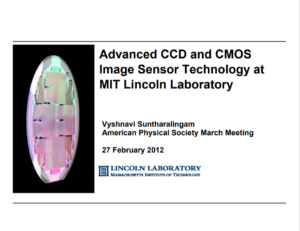
Dr. Vyshnavi Suntharalingam, Group Leader, Advanced Imaging Technology at MIT Lincoln Laboratory, took us through the refinements of design and fabrication that have made silicon and CCDs so important for astronomy. She reviewed the achievements of CCDs, the capabilities of CMOS devices, and some future prospects.
Advanced CCD and CMOS image sensor technology at MIT Lincoln Laboratory
Author: Vyshnavi Suntharalingam, Ph.D., Leader, Advanced Imaging Technology
The Advanced Imaging Technology (AIT) program area at Lincoln Laboratory addresses a broad range of complex imaging problems by using a wide variety of silicon-based imager technologies, including charge-coupled devices (CCDs), active-pixel sensors (APSs), photodiode arrays, and Geiger-mode avalanche-photodiode (GMAPD) arrays that are single-photon sensitive. Many of these devices, including some very large imaging devices that require low defect levels, are fabricated by us from silicon wafers in our class-10 Microelectronics Laboratory. We also operate a fully equipped packaging facility that is capable of developing and performing innovative device packaging of imaging (and other) devices.
In this talk, we present an overview of Lincoln Laboratory’s image sensor technologies, describe how they work and how they are built. We discuss several imaging device parameters that can be optimized for high sensitivity. These include quantum efficiency (including fill-factor), charge-transfer efficiency (moving the charge from the pixel to the output port without loss or added spurious charge), and the noise to read this charge out. The overall goal is to convert most or all of the photons that impinge on the device to photoelectrons and then to read out these photoelectrons without losing any and without adding read noise.<
Further, we will describe design elements or methods that can help with different specific applications: the orthogonal-transfer CCD (OTCCD), an electronic shutter for back illuminated imagers, the Geiger-mode avalanche photodiode (GMAPD) circuit element, and three-dimensionally integrated CMOS focal planes.
Several examples of application to high-sensitivity, high-speed, and broad-wavelength range problems will presented. — SLIDES
